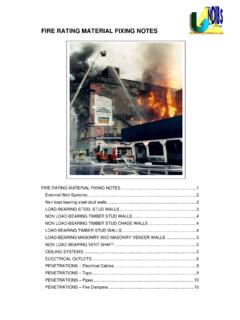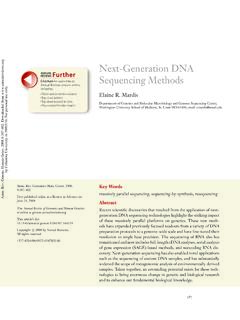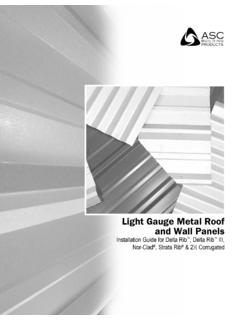Transcription of INSTRUMENTATION LAB MANUAL - Parvathapur, Telangana
1 INSTRUMENTATION LAB MANUAL B. Tech IV Year - I Semester DEPARTMENT OF MECHANICAL ENGINEERING Aurora s Technological And Research Institute Parvathapur, Uppal, Hyderabad-98. NAME : _____ ROLL NO : _____ BRANCH : _____ 2 CONTENTS S. No Topic Page No s 1. Calibration of capacitive transducer for angular displacement. 3 - 6 2. Study and calibration of LVDT transducer for displacement measurement. 7 - 12 3. Study of resistance temperature detector for temperature measurement. 13 - 17 4. Calibration of thermistor for temperature measurement. 17 21 5. Calibration of thermocouple for temperature measurement. 22 25 6. Calibration of hot wire anemometer for temperature measurement. 26 32 7. Calibration of Pressure Gauges 33 - 37 8. Calibration of strain gauge for temperature measurement. 38 43 9. Study and calibration of photo and magnetic speed pickups for the measurement of speed 44 45 10 Study and calibration of a rotameter for flow measurement.
2 46 - 55 3 I N T R O D U C T I O N Introduction to Transducers and Measurement systems: Transducer: Transducer is a device which converts one form of energy into another form like Electrical to Mechanical, Mechanical to Electrical, Thermal to Electrical and etc., Emphasis in the INSTRUMENTATION trainers will be directed toward electronic INSTRUMENTATION systems rather than mechanical systems. In most cases electronic systems provide better data more accurately completely characterize the design or process being experimentally evaluated. Also the electronic system provides an electrical out put signal that can be used for automatic data reduction or for the control of the process. These advantage of the electronic measurement system over the mechanical measurement system have initiated and sustained trend INSTRUMENTATION toward electronic methods. An attempt is made through these INSTRUMENTATION trainer kits to make as easy as possible for the students to learn about the electronic INSTRUMENTATION system and various transducers used for the measurement of mechanical component.
3 The INSTRUMENTATION tutor panels are design in such a way that block diagrams of the stages of electronic INSTRUMENTATION system are clearly pictured on them. This makes the INSTRUMENTATION tutor self explanatory and also the best teaching aid for engineering students. Since the INSTRUMENTATION tutors are not instrument as a whole the accuracy of the measurement cannot be claimed. It is very clear that the INSTRUMENTATION tutors are only for demonstration purpose and cannot be used for any external measurement other than conducting experiments. THE ELECTRONIC INSTRUMENTATION SYSTEM. The complete electronic INSTRUMENTATION system usually contains six sub systems or elements the TRANSDUCER is a device that convert a change in the mechanical or thermal quantity being measured into a change of an electrical quantity. Example strain gauges bonded in to an specimen, gives out electrical out put by changing its resistance when material is strained.
4 The POWER SUPPLY provides the energy to drive the Transducers, example differential transformer, which is a transducer used to measure displacement required an AC voltage supply to excite the coil. SIGNAL CONDITIONERS are electronic circuits the convert, compensate, or manipulate the out put from in to a more usable electronic quantity. Example the whetstone bridge used in the strain transducer converts the change in resistance. AR to a change in the resistance AE. AMPLIFIERS are required in the system when the voltage out put from the transducer signal conditioner combination is small. Amplifiers with game of 10 to 1000 are used to increase their signals to levels they are compatible with the voltage measuring devices. RECORDERS are voltage measuring devices that are used to display the measurement in a form that can be read and interpreted Digital/Analog voltmeters are often used to measure static voltages.
5 DATA PROCESSORS are used to convert the out put signals from the instrument system into data that can be easily interpreted by the Engineer. Data processors are usually employed where large amount of data are being collected and MANUAL reduction of these data would be too time consuming and costly. TRANSDUCER SIGNAL CONDITIONER AMPLIFIER RECORDER POWER SUPPLY DATA PROCESSOR 4 EXPERIMENT CALIBRATION OF CAPACITIVE TRANSDUCER FOR ANGULAR DISPLACEMENT. Displacement measurement by Capacitive Transducer: 5 I N T R O D U C T I O N Unique Capacitance trainer Module is the best trainer for which demonstrate the use of capacitance as a transducer. Two parallel plates (A1), one fixed to the base and the other moving over the fixed plate parallel with a small gap between the two. The over lapping of the plate will act as a capacitor with air as dielectric media. The parallel capacitor is used as a displacement sensor which measure the displacement.
6 The instrument is built around an NE556 integrated circuit. The NE556 is a dual 556 times IC. The first timer is connected as a stable multi vibrator while the second time is sued as a mono stable. At each trigger, the mono stable output a pulse whose width is determined by the Resistance and the Capacitance of the parallel plate capacitor Cx connected across the measuring terminals. Specifically the mono stable duration is given by T= R range X Cx, where R range is the range resistance across the measurement terminals. From this is is seen that the width of the mono stable pulse is directly proportional to capacitance Cx ( parallel plate capacitor). Since the mono stable duration is itself is proportional to capacitance Cx ( parallel plate capacitor) across the measurement terminals, it follows that the meter indicated is directly proportional to the capacitance.
7 The mono stable output is average during averaging circuit and feed to amplified for Zero setting and calibration the instrument to read displacement. Theory Capacitive transducer is a device used to measure the displacement by the following equation C = A/d Where c- capacitance, Dielectric medium, A- Area of overlapping, d- Distance between plates BY capacitive Transducer we have three combinations for measuring Linear and Angular Displacement: 1. Change in the Area of overlapping, 2. Change in the Distance between plates, 3. Change in the Dielectric medium. Here, in this experiment we are going to use Change in the Area of overlapping for finding the LIneasr displacement measaurement Aim: To perform an experiment on Displacement measurement using capacitive transducer O P E R A T I N G P R O C E D U R E Check connection made to the instrument Allow the instrument in On position for 10 minutes for initial warm up Pull the top plate to Zero position Adjust the ZERO potentiometer so that the display reads 000 Move the plate in step of 5 to 10 mm and note down the reading in the tabular column till 50mm.
8 6 S P E C I F I C A T I O N S Sensor : parallel plate capacitor Sensor : Aluminum plates Dielectric Medium : Air Displacement : 0 to 50 mm Accuracy : 5 to 10% Display : digit LED display to read +/- 1999 counts for Power : 230V +/- 10% 50 HZ E X P E R I M E N T & T A B U L A R C O L U M N Measurement of displacement using capacitance is a demo model to demonstrate the use of capacitance as displacement sensor. In measurement Repeatability, Linearity. Accuracy important factors. So the experiment to test the parallel plate Capacitance for all these factors. EXPERIMENT Known displacement is given to the parallel plate and the displacement on the scale can be noted down along with the display readings. Graph of scale reading versus Display reading can be Plotted. Accuracy and the linearity of the Capacitance sensor can be calculated by the graphs, Repeatability can be calculated by repeating the experiment 3 to 4 times and tabulating the readings both for ascending and descending of displacement.
9 TABULAR COLUMN A SL. NO. B ACTUAL SCALE READINGS (MM) C INDICATOR READINGS (MM) D ERROR B-0 E % ERROR Questions: 1. What is the principle of working of capacitive transducer? 2. What is calibration? 3. How capacitive transducer used for displacement measurement? 4. What are the advantages of capacitive transducer? 5. What is the replacement for displacement measurement if capacitive transducer is not there? 7 EXPERIMENT STUDY AND CALIBRATION OF LVDT TRANSDUCER FOR DISPLACEMENT MEASUREMENT Displacement Measurement by LVDT 8 I N T R O D U C T I O N The primary object of the INSTRUMENTATION TRAINER is to introduce and to educate electronic INSTRUMENTATION systems in a manner sufficiently complete that the students will acquire proper knowledge and the idea about the transducers and their applications to measure mechanical and terminal quantities. The mechanical quantities include strain, force, pressure torque displacement, acceleration, frequency, etc.
10 The terminal quantities include temperature and heat flux. It is understood that the students will have a conceptual understand of these quantities through exposure of mechanics or physics courses, such as static s dynamics, strength of materials or thermodynamics. The students experience in actually measuring these quantities by conducting experiments, however, will usually be quit limited. It is an objective of this tutor to introduce methods commonly employed in such measurements and the usage of such electrical components such as capacitance, resistance, inductance, intensity, etc. Emphasis in the INSTRUMENTATION trainer will be directed toward electronic INSTRUMENTATION systems rather than mechanical systems. In most cases electronic systems provide better data more accurately completely characterize the design or process being experimentally evaluated. Also the electronic system provides an electrical out put signal that can be used for automatic data reduction or for the control of the process.






